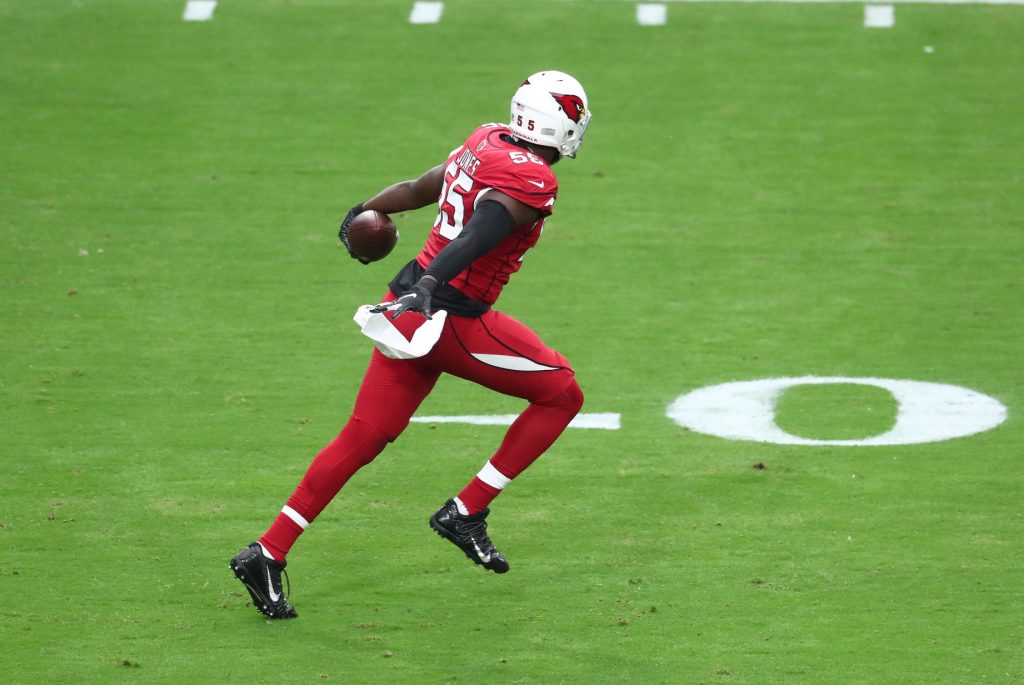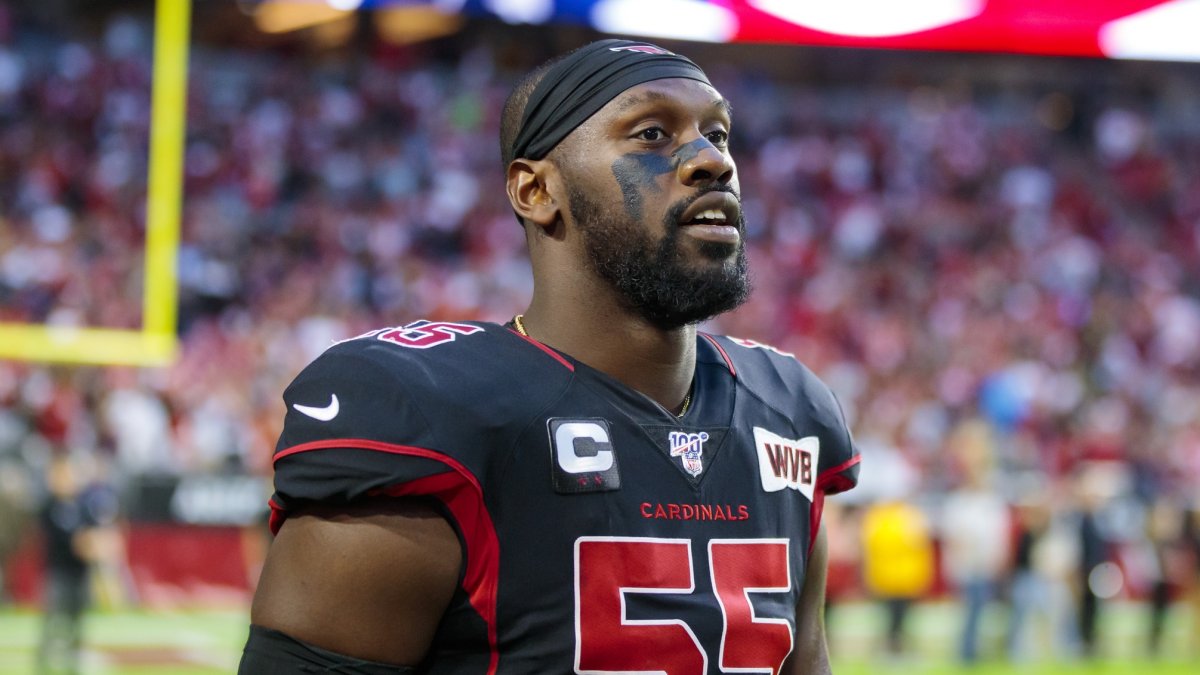Chandler Jones wants out of Arizona.
Per ESPN’s Jeremy Fowler, Jones has officially requested a trade from the Arizona Cardinals. The nine-year NFL veteran edge defender is unhappy with his contract, but the Cardinals’ brass doesn’t want to trade Jones and expects him to report to training camp on Tuesday.
Jones ranked fourth among all qualifying edge defenders in PFF pass-rushing grade (90.0) in 2019. He also recorded 75 total pressures and T-16th in PFF pass-rush win rate (16.8%) that season. He only played 286 total defensive snaps and earned a 62.6 PFF grade before suffering a season-ending torn biceps injury in 2020.

Even though Jones is coming off a severe injury and entering his age 31 season, he is right to seek further assurances from Arizona. He is entering the final year of his five-year, $82.5 million extension signed in 2017 and due a $15.5 million non-guaranteed base salary. Only 5.5 sacks away from setting the Cardinals franchise record, Jones is a crucial element to a pivotal 2021 campaign.
Arizona’s defense ranked 14th in EPA per play allowed and seventh in total pressure rate (36%) in the 11 games without Jones (Weeks 6-17) in 2020. Veterans Haason Reddick and Markus Golden both earned 75.0-plus PFF pass-rushing grades as the team’s top tandem in Jones’ absence. Golden signed a two-year contract this offseason to stay with Arizona, but Reddick instead signed a one-year, $6 million contract with the Carolina Panthers.
Arizona also signed veteran JJ Watt to a two-year, $28 million contract this offseason. The 32-year-old edge defender has earned a 75.0-plus PFF pass-rushing grade in eight of the last nine seasons. He recorded 45 total pressures and ranked seventh among all NFL edge defenders in PFF grade (85.4) in 2020.
Jones is still a top-20 edge defender in the NFL and a key piece to the Cardinals’ window to chase a deep postseason run with Kyler Murray still on his rookie contract.
Murray is entering the third year of his rookie deal and will be eligible for an extension after the season. Rookie quarterback contracts drive extra cash and cap flexibility, which allowed for the Cardinals to follow in the Buffalo Bills’ and Cleveland Browns’ footsteps in loading up on expensive talent in free agency or via trade (DeAndre Hopkins).
If the two sides cannot work out a multi-year extension, there are two solutions Jones and his camp may point to in order to end a potential holdout. The first would be emulating what the New England Patriots and cornerback Stephon Gilmore agreed to last offseason, effectively giving Gilmore a $5 million pay raise for the 2020 season. Gilmore, coincidentally, is the player New England was able to pay up for in free agency after they traded Jones to Arizona back in 2017.
The other option could be akin to what the Minnesota Vikings recently did with edge defender Danielle Hunter’s contract to get him back in the building, converting a chunk of his salary into a signing bonus in order to give him cash upfront and also reworking his 2022 contract year to essentially force an extension or release. Here, Jones is only under contract for the 2021 season. However, perhaps Arizona could convert some salary into a bonus and also add a no-tag provision to his contract, thus ensuring he will hit the open market in 2022 if he so chooses.
For now, Jones’ $20.8 million 2021 cap hit ranks fourth among edge defenders and accounts for roughly 11.4% of the total 2021 salary cap. Arizona also stands to benefit here from a salary cap perspective if they can work out a multi-year extension and spread some of that cap hit down the line.
If no solution can be agreed to, which seems unlikely given the importance of Jones to a team mired in the second-longest playoff drought in the NFL, there should be a long list of teams interested in a trade. The Buffalo Bills and Baltimore Ravens immediately come to mind even after using first-round selections on edge defenders. Both clubs are entering the final rookie-contract year for their respective franchise quarterbacks in Josh Allen and Lamar Jackson and could solidify Super Bowl-caliber rosters with a splash for Jones. The Las Vegas Raiders also make sense as a team that has been working to upgrade their pass-rush unit for years but could still use a true No. 1 option.
A second-round pick would most likely be the top draft pick Arizona could recoup in a Jones trade because of his age and the fact he’d be looking for a new contract wherever he ends up. If Jones shows a willingness to play elsewhere without a new deal, an acquiring team may take the gamble of bringing him aboard for just one year with the hopes of earning a third-round compensatory draft pick following the 2021 season. The Ravens adopted this approach in 2020 with their mid-season acquisition of edge defender Yannick Ngakoue, sending a 2021 third-round and 2022 fifth-round pick to the Vikings. Ngakoue’s free agent contract with the Raiders subsequently awarded the Ravens a fourth-round compensatory pick in 2022.
Finally, a true blockbuster idea that could help two teams resolve contract-related holdout situations – and benefit both immensely on the football field – would be a swap of Jones for Miami Dolphins cornerback Xavien Howard. The star Dolphins cornerback is also unhappy with his contract situation, and the Cardinals are thin at the cornerback position even following the addition of Malcolm Butler in free agency. From a salary cap perspective, the move is close to net neutral, as Miami would just take on an additional $3.425 million in 2021 cap commitments barring any potential restructuring. Jones could then serve as a veteran mentor to 2021 No. 18 overall pick edge defender Jaelan Phillips. Arizona would likely have to throw in some minor draft capital on top of the player swap, but a Day 3 pick may be all that’s needed.
Arizona should push to keep Jones under contract if the team can work enough cap magic to get it done, but expect teams like Miami, Baltimore and Buffalo to take to the phones to chase Jones’ services if GM Steve Keim and the Cardinals do indeed make Jones available.



 © 2025 PFF - all rights reserved.
© 2025 PFF - all rights reserved.